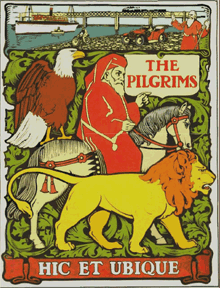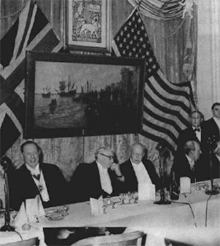Difference between revisions of "The Pilgrims Society"
| Line 28: | Line 28: | ||
Both are '''Must-Reads''' for anyone seeking to understand Quigley's "Anglo-American Establishment". | Both are '''Must-Reads''' for anyone seeking to understand Quigley's "Anglo-American Establishment". | ||
| + | |||
| + | ==See Also== | ||
| + | *[[Document:Pilgrims Society Address 2002]] - Remarks by Assistant Secretary Richard Boucher to the Pilgrims Society meeting in London on 28 November 2002. | ||
==References== | ==References== | ||
Revision as of 21:21, 11 November 2010
The Pilgrims Society is a British-American society established 1902. The patron of the society is Queen Elizabeth II.
In so far as the general public are aware of its existence at all, that awareness is, in all probability confined to its established custom of holding dinners to welcome into office each successive U.S. Ambassador to the United Kingdom and each new British Ambassador to the United States. But there is a lot more to the The Pilgrims Society than hosting the odd old-boys dinner party.
Contents
Introduction
At the turn of 20th century a number of influential persons were interested in bringing the establishments of the United States and Great Britain closer together. The St. George's Society in New York, the American Society in London, and the growing network of Anglo-American League branches in England (founded by a good number of later Pilgrims Society members), were seen as inadequate, so the idea arose to form a new, elitist society with branches in both London and New York. This became the Pilgrims Society, which organized regular meetings in such prestigious hotels as the Victoria, the Waldorf Astoria, the Carlton Ritz, and the Savoy.
The idea of setting up what ultimately became the Pilgrims Society was first discussed by a number of Americans working in London. One of them was Lindsay Russell, a well-connected lawyer from New York, who regularly visited London in these days to set up his law firm Alexander and Colby. It was Russell who got together with General Joseph Wheeler (on a visit in London), General Lord Roberts, and Sir Harry Brittain. Together they organized the original meeting of the Pilgrims of Great Britain at the Carlton Hotel on July 11, 1902. The meeting was a success and two weeks later Lord Roberts was elected president of the Pilgrims; Lord Grenfell and Admiral Hedworth Lambton became vice presidents. Two other vice presidents were Americans: Senator Chauncey M. Depew (Yale Skull & Bones 1856; lawyer to Cornelius Vanderbilt; member of J.P. Morgan's elite Corsair Club, together with William Rockefeller) and General Joseph Wheeler. Sir Harry Brittain became secretary and the Archdeacon of London, William MacDonald Sinclair, was elected chairman of the executive committee [1]
Muted public observations on The Pilgrims
"Tragedy and Hope" is a seminal post WWII work on the Anglo-American Establishment. [2] The consequences of publication for it's author Professor Carroll Quigley was to be effectively black-balled by the Anglo American Establishment. In spite of the revelations and interpretation of US/UK history through the century to its publication in 1966 which gave such displeasure to powerful interests, Quigley never mentioned The Pilgrim Society by name. Nevertheless, the following brief passage is a good precis of The Pilgrims and their objectives:
"[The aim of the international bankers was] nothing less than to create a world system of financial control in private hands able to dominate the political system of each country and the economy of the world as a whole. This system was to be controlled in a feudalist fashion by the central banks of the world acting in concert, by secret agreements arrived at in frequent private meetings and conferences." [2]
And from John T Whiteford:
"There are several curious things about these Pilgrims functions. In the first place there is present at these dinners an array of notables such as it would be difficult to bring together under one roof for any other purpose and by any other society... Among the guests were John D. Rockefeller and J.P. Morgan, Thomas W. Lamont and other members of the House of Morgan... We are entitled to know what the Pilgrim Society is, what it stands for, and who these powerful Pilgrims are that can call out the great to hear a British Ambassador expound to Americans the virtues of a united democratic front." [3]
The most comprehensive study to date
Most of the internet references to The Pilgrim Society are recent (ie post 2000) and owe much to a seminal study by Joel Van der Reijden originally posted on his ISGP web site which is no longer available directly. In particular the brief Wikipedia (November 2010) article relegates The Pilgrims to the category of "Dining Clubs" and is restricted to anodyne mention of the ambassadors' dinners custom plus a similarly anodyne claim about its objectives by an American Diplomat. [4]
The ISGP study is contained in two separate html pages and is available from the WikiSpooks archive of the ISGP site as follows:
- ISGP - The Pilgrims Society - A study of the Anglo-American Establishment.
- ISGP - Pilgrims membership list and sources.
Both are Must-Reads for anyone seeking to understand Quigley's "Anglo-American Establishment".
See Also
- Document:Pilgrims Society Address 2002 - Remarks by Assistant Secretary Richard Boucher to the Pilgrims Society meeting in London on 28 November 2002.

